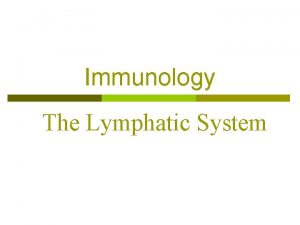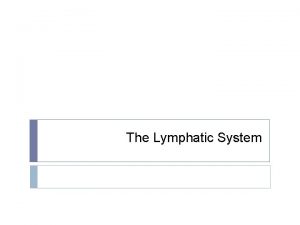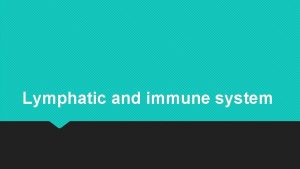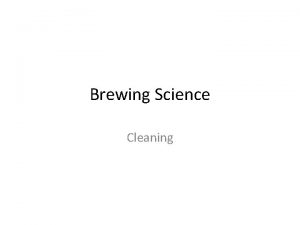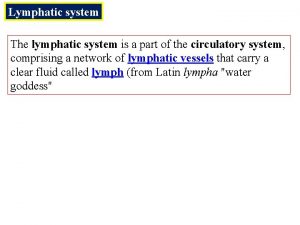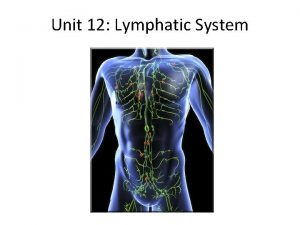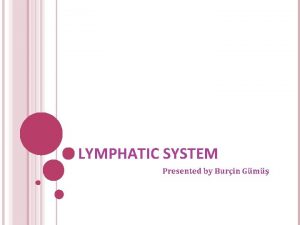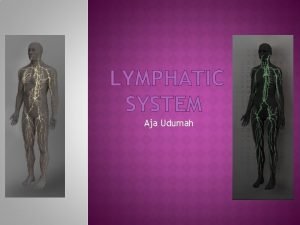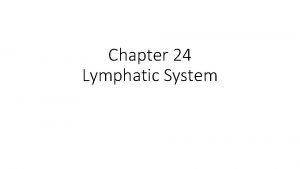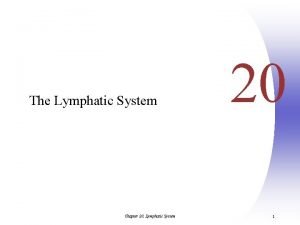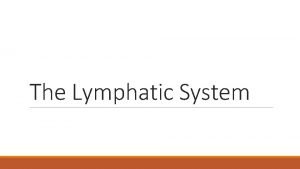LYMPHATIC SYSTEM The Lymphatic System Cleaning system of























- Slides: 23

LYMPHATIC SYSTEM

The Lymphatic System Cleaning system of the body Drains all extra fluid from the tissues Closely associated with the vascular system Looks like veins with thin walls and valves Contains: Capillaries Nodes Vessels

Functions Protects against foreign materials Bacteria Viruses Fungi Protozoa pathogens Absorbtion of fats Lymphatic vessels called lacteals transport fats to the circulatory system

Lymphatic System Composition Lymph Vessels Nodes and glands Nodules Spleen Thymus gland

Lymph Fluid Straw colored Similar to plasma Functions: Maintains blood volume and blood pressure by returning tissue fluid to blood Returns small proteins to blood Moves by: Same mechanism facilitating venous blood return to the heart Contractions of vessels between valves

Lymph Vessels Found close to veins Superficial deep Structure similar to veins Thin-walled – 1 layer endothelium Contain valves More permeable Carry lymph into and out of lymph nodes and finally back to the vascular system One way system – flowing toward the heart Named according to location

Lymph Vessels NOT located in the: Cuticles Hair CNS Eyeball Bone marrow Spleen Nails Epidermis Cartilage Inner ear

Lymph Vessels - Capillaries Begin as dead end capillaries in the tissue Very permeable Collect tissue, fluid and protein Specialized: Lacteals – transfer fatty acids and vitamin A Found in intestines

Order of Flow Lymphatic vessels join to form lymphatic trunks Lymphatic trunks join to form : Thoracic duct (3/4 of body) aka – left lymphatic duct Right lymphatic duct (drains right arm, and right side of head, neck and upper torso These empty into subclavian veins at junction with internal jugular vein Capillaries merge to form larger lymph vessels which flow into regional nodes Lymph vessels carry lymph away from regional nodes to right or left lymphatic ducts

Right Lymphatic Duct Receives lymph from upper right quadrant of the body Empties into right subclavian vein Opening into vein contains semilunar valves that prevent blood back flow

Left Lymphatic Duct (thoracic duct) Receives lymph from all parts of body except the upper right head, neck and chest Larger of the two ducts Temporary storage area – cysterna chyli

Flow chart Lymphatic capillary Lymphatic vessel Lymph node Lymphatic vessel Lymphatic trunk Collecting duct filtered Before the heart – cysterna chyli Subclavian vein Returns through cardiovascular system

Lymph Nodes and Nodules Small lymphatic tissue masses located along lymph vessels Lymph is filtered here Found in clusters Waste-water treatment plants Vary in size Centers for lymphocyte production – what does this do? Primary groupings – cervical, axillary, and inguinal Site of cancer growth Lymph nodule DO NOT Filter fluid

Node and Nodules cont…. Structure: Fibrous connective tissue capsule with partitions Inside lymphocytes and macrophages Main groups: Cervical Axillary Tracheobronchial Mesenteric Inguinal Inflammation of lymph nodes - BUBOS

Lymph Movement If flow of lymph is interrupted – edema results Sometimes surgery can cause this because they are removed or disturbed Lymph nodules Do not filter fluid Found beneath moist epithelium of mucous membrane Digestive system Respiratory system Urinary system

Mucosa Associated Lymphoid Tissue MALT Lymph nodules are also found singly or in groups Peyer’s patches in ileum Tonsils Some in appendix

Lymphatic Organs Primary Organs Red bone marrow Thymus Lymph nodes Secondary Organs Lymph nodules Spleen

Tonsils Act as a filter against disease Palatine Pharyngeal Bilaterally soft palate Located on the posterior wall of the upper pharynx Lingual Located posterior portion of the tongue

Thymus Located: Upper thorax, in mediastinum above heart Most activity during fetal and prepubescent period Larges at age 10 -12 then atrophies Most thymus material replaced by fat and connective tissue Produces hormone thymosin Matures T-lymphocytes Promotes growth/activity of lymphocytes throughout the body

Spleen Largest lymphoid organ Upper left quadrant Protected by rib cage

Functions of spleen Blood formation Blood filtration All blood cells in fetus Only lymphocytes and monocytes after birth Removes bacteria, particles, worn out RBC’s and platelets Blood storage Can contain over one pint of blood If the spleen is damaged it is removed and you will suffer from a weakened immune system – not considered a vital organ

Reticuloendothelial system System of cells that: Destroy old blood cells Foreign substances Cancer cells Cells are found in: Liver Spleen Bone marrow Lymph nodes brain

Disorders of the lymphatic system Lymphangitis Septicemia Lymphadenitis Lymphedema Elephantiasis Lymphadenopathy Mononucleosis Splenomegaly Lymphoma Hodgkins Non – Hodgkin’s lymphoma
 Lymphatic system vs endocrine system
Lymphatic system vs endocrine system Red and white blood cells difference
Red and white blood cells difference 3 step fuel system cleaner
3 step fuel system cleaner Hát kết hợp bộ gõ cơ thể
Hát kết hợp bộ gõ cơ thể Lp html
Lp html Bổ thể
Bổ thể Tỉ lệ cơ thể trẻ em
Tỉ lệ cơ thể trẻ em Chó sói
Chó sói Tư thế worm breton
Tư thế worm breton Hát lên người ơi
Hát lên người ơi Các môn thể thao bắt đầu bằng tiếng chạy
Các môn thể thao bắt đầu bằng tiếng chạy Thế nào là hệ số cao nhất
Thế nào là hệ số cao nhất Các châu lục và đại dương trên thế giới
Các châu lục và đại dương trên thế giới Công của trọng lực
Công của trọng lực Trời xanh đây là của chúng ta thể thơ
Trời xanh đây là của chúng ta thể thơ Mật thư anh em như thể tay chân
Mật thư anh em như thể tay chân Làm thế nào để 102-1=99
Làm thế nào để 102-1=99 Phản ứng thế ankan
Phản ứng thế ankan Các châu lục và đại dương trên thế giới
Các châu lục và đại dương trên thế giới Thơ thất ngôn tứ tuyệt đường luật
Thơ thất ngôn tứ tuyệt đường luật Quá trình desamine hóa có thể tạo ra
Quá trình desamine hóa có thể tạo ra Một số thể thơ truyền thống
Một số thể thơ truyền thống Bàn tay mà dây bẩn
Bàn tay mà dây bẩn Vẽ hình chiếu vuông góc của vật thể sau
Vẽ hình chiếu vuông góc của vật thể sau


























